Product marketing wasn’t a part of my plan. To be honest I wish I had an insight into what options were available to me in school. Especially in the local curriculum (LK), things are pretty straightforward. Study biology if you want to be a doctor, Maths if an engineer, Business/Arts if you want to an easy way out. I wanted the easy way out, I studied Business.
Working in tech wasn’t really something I accounted for because I thought … does this mean I have to code? A few years into my career at WSO2 I was offered the option of either taking on field-marketing or product marketing for the IAM product and the latter sounded like an adventure. One reason being that middleware isn’t the most straightforward thing to explain. My parents tell people that I look at a screen, type, and get on calls a lot. That’s not entirely wrong. But I’ve done a 12m base jump at an adventure park and I thought I’m brave enough to take anything. In retrospect, that jump was easier.
Product marketing is a beautiful cross-functional role that a lot of companies are still figuring how to navigate through. It’s also a role that PMMs ourselves are trying to define. But for the sake of a definition, we’re a bridge between sales, product, and customers. At first, your team can be confused as to know what your role might be; a growth hacker? A demand gen person? PM? It’s actually having a sense of all these so you can get the product off the shelf. See…that’s not so bad.
I wanted to write about my experience because I recently had a conversation with someone on how can they get started with their own PMM practice. While I’m not a veteran, I can definitely give some tips on what not to do. Or maybe a little on what you can.
Getting started, I was nervous but I also wanted to prove self and my methods were haphazard. How do I let everyone know I’m not a complete idiot? I come from an 8-year corp experience, yes but that’s all advertising and communications. It was during these times VP/Deputy of IAM (Prabath Siriwardena) sat me down and gave me good advice — “Take a step back, tell yourself you have nothing to prove, and use your first year to learn”.
That helped.
If you’re someone who is thinking of getting started in product marketing, this is for you.

Get to know the product
Sit with the product teams and ask silly questions and a million whys till you get it. Even if you don’t — especially if it’s too technical- that’s ok (cutting myself some slack here). Write it down and explain it to yourself till you understand to give someone you meet in a conference an elevator pitch. During my first presentation to the field, I was nervous so the advice I got was to think of any question I couldn’t answer as an “action item” to work on later. Something we did when we got started was filling out a “messaging document” that contained the positioning, capabilities/features, the benefits, and value props. Filling this document get you researching hence a good headstart (If you’d like the template, give me a shout).
If your company offers training on the product, join that. Ishara Karunarathna, the head of engineering of our team last year conducted sessions to test out our training materials and I gladly sat down to learn. He also encouraged me to sit during product meetings just so I could familiarise myself with the terms and jargon. I still sit down with the product team and pepper them with questions to craft material (Just in case any of you guys are reading, thank you for letting me do this countless times).
Get to know your customers
Listen in during calls and know what the customers are saying. Honestly sometimes, crafting your positioning and value props is much easier if you just listen to your customers. They would actually say things like “I think one of the biggest benefits you guys have is…”. Similarly, they will also tell you where you need to improve and what features you’d need. I also read customer case studies, spend sometime segmenting the types of companies, industries so you know where your strengths. This is also a good time to do potential audience research. Which titles should you go after exactly? I would take a list of leads and segment them based on job titles to see who reaches out the most. We built a slide deck on our ICP with both user personas and buyer personas and I’ve divided it into behavior and tasks. I listed down stuff ranging from what kind of tv shows they watch, what kind of hobbies they engage in their day to day responsibilities (feel free to look at job descriptions advertised). I also tested this out with the product teams to see if it resonates with them.
Get to know your competition
If you’ve read this blog I’ve written on stalking the competition, you’ll know how long I spend doing this. This is not an attempt to copy any competitor or to benchmark it. Because then you’re including their flaws too. But it’s always a good idea to know their products, events they take part in, what they talk about, their positioning, and how they try to get new customers.
Take stock of all the marketing material the product has now that’s customer or prospect facing
Got a basic white paper? Product video? This could be a time get as basic content plan fleshed out so you have the basic resources covered. I’ve covered this via this short post here. I also ran a survey with our sales team a couple of years back because they definitely have good ideas on what kind of content, product comparisons your prospects are looking for.
Decide what you’re going to measure
For us, it makes sense to look at product downloads and then how many leads we’re generating. I also look at those looking at the “bottom of the funnel content “so you know they may be interested in learning more about the product that just shopping around. This is quite important because you’d want to know later on if your activities are successful.
How can you help the sales team?
Sales enablement plays a huge role for PMMs. This is also another question you could ask when talking to your sales team on what kind of content they would need. Typically you’d need to start with
- Battlecards
- Product comparisons
- A quick overview of the product
- sales decks etc.
It’s a bit overwhelming to have all of these at once but this is where you would usually need to start. All that competition research we spoke about before is helpful here.
If you’re looking at theory and would like to read more about becoming a PMM, I’d like to recommend Obviously Awesome by April Dunford and The Product Marketing Manager: Responsibilities and Best Practices in a Technology Company by Lucas Weber. The former is a great tool of positioning and the 2nd one is a good way to know you’re not alone.
After you spend your first 3–6 months figuring these out, you’ll probably be expected to carve the GTM or maybe even simultaneously. That itself can be a super fun(?) process but that’s a topic for another day.
Any other tips for those getting started?






.png)
.png)










 Follow us on LinkedIn
Follow us on LinkedIn



.svg?v=1b8371da9d)